The Homer IPTs
No Reasonable Offer Refused
I hate sailing with a less than full boat. If you would like to make a low-ball offer on one or more of the Bald Eagle IPTs below, please click here.
IPT #1: MON 20 FEB 2023 through the full day on FRI 24 FEB 2023. Five full days/20 hours on the boat: $5500.00. Limit 5 photographers/Sold Out
IPT #2: SAT 25 FEB 2023 through the full day on THURS 2 MAR 2023. Six full days/24 hours on the boat: $6600.00. Limit 5 photographers/Openings: 3.
IPT #3: FRI 3 MAR 2023 through the full day on TUES 7 MAR 2023. Five full days/20 hours on the boat: $5500.00. Limit 5 photographers. Openings: 1.
Rooms at Land’s End Resort are currently available for all of the dates above.
What’s Up?
It was clear and sunny with a brisk wind from the north on Saturday morning. The two eagle chicks were quite active, flapping and jumping about in the nest, but always facing north — just a bit away from the light (as the sun was in the southeast). I created a few still images including today’s featured image, and made some nice crane and vulture head portraits as well. The cranes have been acting romantically the last two mornings; while concentrating on the eagle nest, I missed two copulations and several refused invitations.
I swam my half mile for the third straight day despite the cooler air temps. And I got more work down on my 2022 taxes.
I headed back down to the lake 25 minutes before the time of sunset. Things were looking great until the sun dipped behind a long low cloud on the western horizon. Surprisingly, I did quite well after that making some bright sky silhouettes and creating pleasing blurs of large flocks of Boat-tailed Grackles swirling above the lake.
Today is Sunday 5 February 2023. The forecast for this morning is cloudy skies with a brief rain shower at about 8:00am and a northeast breeze. I will be heading down to the lake if it brightens up. This blog post took about 90 minutes to prepare and makes three hundred thirteen days in a row with a new, educational post. Wherever you are and whatever you are doing, I hope that you too have a great day.
Please, please, pretty please remember to use my B&H or Bedford’s affiliate programs for all your new gear purchases.
The plan is to continue to post every day until the streak reaches one year and one day and then go back to posting every other day.
Please remember to use the B&H and Amazon links that are found on most blog pages and to use the BIRDSASART discount code at checkout when purchasing your new gear from Bedfords to get 3% back on your credit card and enjoy free second-day air FedEx. Please, also, consider joining a BAA IPT. You will be amazed at how much you will learn!
You can find some great photo accessories (and necessities, like surf booties!) on Amazon by clicking on the Stuff tab on the orange/yellow menu bar above. On a related note, it would be extremely helpful if blog-folks who, like me, spend too much money on Amazon, would get in the habit of clicking on the Amazon logo link on the right side of each blog post when they shop online. As you might expect, doing so will not cost you a single penny, but would be appreciated tremendously by yours truly. And doing so, works seamlessly with your Amazon Prime account.
Please remember that if an item — a Delkin flash card, or a tripod head — for example, that is available from B&H and/or Bedfords, is also available in the BAA Online Store, it would be great, and greatly appreciated, if you would opt to purchase from us. We will match any price. Please remember also to use my B&H affiliate links or to earn 3% cash back at Bedfords by using the BIRDSASART discount code at checkout for your major gear purchases. Doing either often earns you free guides and/or discounts. And always earns my great appreciation.
Branching Eaglets Indian Lake Estates In-the-Field Workshops
Join me for two hours of instruction at Indian Lake Estates any day from now through the morning of Monday 13 February: $200.00. Add a working brunch with image review and a Photoshop session for another $100.00 to round out an incredibly educational morning. Though we will concentrate on the baby eagles, there is lots going on right now. Backup subjects include Sandhill Cranes, Ospreys building nests, and more. If you would like to set up a session on a suitable weather morning, please contact me via e-mail.
Induro GIT 304L Tripod
Out of production for more than two years, BAA sold its last one in December. The good news? We now have two more new-in-the-box tripods. They are now available for shipping. Best to order yours now to be sure that you get one. The 304L was my go-to tripod for more than a decade. Best to grab order yours right now to avoid being disappointed.
|
|
|
This image was created on 4 February 2023 down by the lake near my home at Indian Lake Estates. I used the no-longer available Induro GIT 304L tripod/Levered-Clamp FlexShooter Pro-mounted Sony FE 600mm f/4 GM OSS lens, the Sony FE 2.0x Teleconverter, and The One, the Sony Alpha 1 Mirrorless Digital Camera). The exposure was determined via Zebra technology with ISO on the thumb dial. ISO 1600. 1/1000 sec. at f/8 (wide open) in Manual mode. When evaluated in RawDigger, the raw file brightness was determined to be dead-solid perfect. AWB at 7:47:51am on a sunny morning. Tracking: Spot S/AF-C with Bird-Eye/Face Detection performed perfectly. Click on the image to enjoy the high-res version. Be sure to click on the image to enjoy a high-res version. Image #1: Two large Bald Eagle chicks in the nest |
Murphy’s Law of Nests
Murphy’s Law of Nests states that all bird nests have a least one twig or stick too many. This season’s ILE eagle nest has three such sticks. The most offensive one is the large branch on our right. The second such stick is in the center of the nest and intersects with the chick on our left. Continuing left, the third and least problematic branch is sticking straight up. I could have left that one as it did not merge with either chick. What looks to be the smaller chick on our right seemed to be admiring its larger nest-mate when I pressed the shutter button.
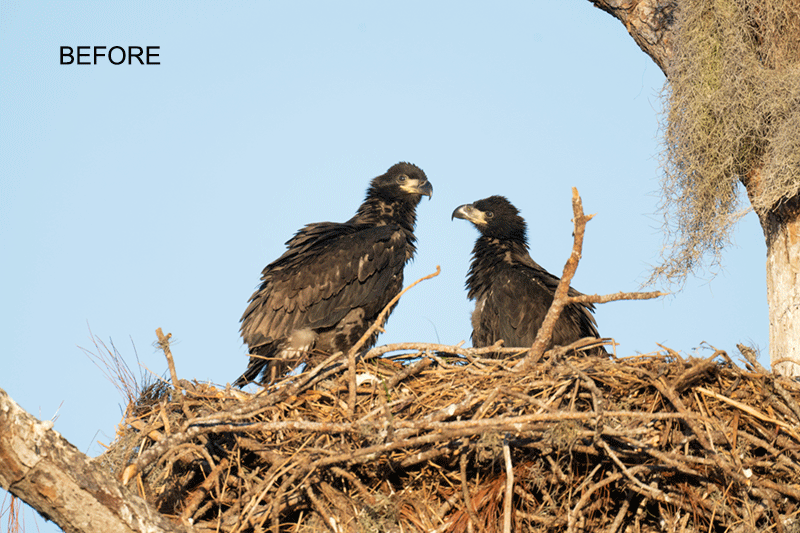
|
What to Do About Murphy’s Law
If — as mine do — your photographic ethics allow for image clean-up, you can use a variety to Photoshop tools to tidy things up. For today’s featured image I used the Patch Tool and the Clone Stamp Tool to Divide and Conquer the sticks that merged with the chicks. I used Content-Aware Fill to lose the remaining stubs of branches that were stabbing the chicks. It performed beyond amazingly well. The Spot Healing Brush was used to eliminate some bright leaves and whitewash from the nest itself.
Divide and Conquer
Last year, when I discovered that Divide and Conquer had been inadvertently omitted from Digital Basics II, I shared the technique in a blog post.
Here, adapted from the last update to the original Digital Basics, is how you do it:
Let’s say that you have a long branch in the background that needs to be removed. Best would be to cover it with a Quick Mask. But, in many instances, there is simply not enough matching background with which to cover the distracting branch. The Patch Tool is greatly preferred to the Clone Stamp as the Patch Tool blends texture while the Clone Stamp copies texture-less color. It is often impossible to patch a long branch in one fell swoop, and if you try the Patch Tool on small sections of the branch, you will encounter terrible smudging. What to do? Divide and Conquer. By cutting the offending branch into two or more pieces, you can create manageable sections. Loggers cut a big tree trunk into sections that can be much more easily handled than the entire trunk. To cut up your distracting branch, use the Clone Stamp Tool. Note: if the tonality on one side of the branch is of a slightly different tonality or color than the other, be sure to work from both sides. Once you have cut the branch into manageable sections, you can use the Patch Tool to eliminate the remaining sections. And you can use Content-Aware Fill to eliminate small sections of the branch that are jabbing and merging with the subject.
|
|
The BIRDS AS ART Current Workflow e-Guide (Digital Basics II).You can order your copy from the BAA Online Store here, by sending a PayPal for $40 here, or by calling Jim or Jennifer weekdays at 863-692-0906 with your credit card in hand. Be sure to specify Digital Basics II. |
The BIRDS AS ART Current Workflow e-Guide (Digital Basics II)
The techniques mentioned above and tons more great Photoshop tips and techniques — along with my complete digital workflow, Digital Eye Doctor Techniques, and all my personalized Keyboard Shortcuts — are covered in detail in the BIRDS AS ART Current Workflow e-Guide (Digital Basics II), an instructional PDF that is sent via e-mail. Note: folks working on a PC and/or those who do not want to miss anything Photoshop may wish to purchase the original Digital Basics along with DB II while saving $15 by clicking here to buy the DB Bundle.
Folks who learn well by following along rather than by reading can check out the complete collection of MP 4 Photoshop Tutorial Videos by clicking here. Note: most of the videos are now priced at an amazingly low $5.00 each.
You can learn how and why I converted all of my Canon digital RAW files in DPP 4 in the DPP 4 RAW Conversion Guide here. More recently, I became proficient at converting my Nikon RAW (NEF) files in Adobe Camera Raw. About three years ago I began converting my Nikon and Sony RAW files in Capture One and did that for two years. You can learn more about Capture One in the Capture One Pro 12 Simplified MP4 Video here. The next step would be to get a copy of Arash Hazeghi’s “The Nikon Photographers’ Guide to Phase One Capture One Pro e-Guide” in the blog post here. Today, I convert my Sony raw files in Photoshop with Adobe Camera Raw.
You can learn advanced Quick Masking and advanced Layer Masking techniques in APTATS I & II. You can save $15 by purchasing the pair.
|
|
Image #1A: The optimized version of the Two large Bald Eagle chicks in the nest image |
The Optimized Image
The before image shows two large eagle chicks in their nest. The optimized version shows two large eagle chicks in the nest. Which one do you like best? Why?
|
|
Image #1B: A 100 percent crop of the Two large Bald Eagle chicks in the nest image |
Astounding 1200mm Sharpness
I continue to be amazed, even astounded, by the sharpness and image quality of Sony A1 images created with the 600 f/4 GM and the 2X teleconverter.
Note: As AF was on the chick on our right that was slightly farther away than the chick on our left, the head of the chick on our left was selectively sharpened. First, I applied a Contrast Mask. Next, I brought the image into Topaz Sharpen AI, painted a mask of the head of the bird on our left, and went with Standard/Lens Blur. This was done on the .TIF file.
Directions to the Eagle Nest
Directions to the eagle nest tree will be included with your purchase of the BAA Middle of Florida Photographic Site Guide. If you already own a copy of that guide, please shoot me proof-of-purchase via e-mail and request the location of the nest.
|
|
The BAA Middle of Florida Photographic Site GuideYou can purchase your copy here in the BAA Online Store. |
The BAA Middle of Florida Photographic Site Guide
126 pages, 87 photographs by Joe Przybyla and Arthur Morris.
The PDF for this e-Guide is an electronic download sent via e-mail.
Purchase your copy here in the BAA Online Store.
I had thought about doing a guide to some of the great but little-known photo hotspots around central Florida for about a decade, but those plans never came to fruition. I met Joe online in the Avian Forum at BirdPhotographer’s.Net about two years ago. Joe’s photography has improved tremendously over the past few years; he credits the BAA blog, my books and PDFs, and his participation on BPN. The one thing that I learned right from the get-go about Joe is that he is a hard and tenacious worker, always striving to improve his skills and to grow his knowledge base. As he knew of more than a few good spots in central Florida, I broached the idea of us doing a photographic site guide that covered many of the little-known photographic hotspots from Brandon to Lakeland to Joe Overstreet Road to Indian Lake Estates (my Florida home for the past 20 years or so). After more than many, many dozens of hours of effort, The BIRDS AS ART Middle of Florida Photographic Site Guide is now a reality. Thanks to Joe’s wife Dottie for her review of our writing. We all learned once again that writing is a process, a back-and-forth process. All thanks to the white pelicans of Lakeland. Here are the locations that are detailed in this e-Guide:
- Indian Lake Estates: Sandhills Cranes with chicks and colts, lots of vultures, and Ospreys up the kazoo!
- Gatorland, Kissimmee: Learn to make great images of wading birds in a cluttered rookery.
- The Brandon Rookery: Great for nesting Wood Storks, Great Egrets, and more.
- Circle Bar B Reserve, Lakeland: Here you will find a great variety of avian subjects in a great variety of habitats.
- Lake Morton, Lakeland: There are lots of silly tame birds here including and especially American White Pelican during the colder months.
- Lake Mirror, Lakeland: Tame Anhingas, Limpkins, and a zillion White Ibises at times.
- West Lake Parker, Lakeland: Here you will have a chance for two difficult birds, Snail Kite, and Purple Gallinule.
- Joe Overstreet Road, Kenansville: Crested Caracara, meadowlarks, Loggerhead Shrike, and much more on the fenceposts and barbed wire.
Each location includes a map, a detailed description of the best spots, best season, light and time of day instructions, the expected species, and an educational and inspirational gallery that is designed to open your eyes as to the possibilities.
You can purchase a copy here in the BAA Online Store.
Typos
With all blog posts, feel free to e-mail or to leave a comment regarding any typos or errors.

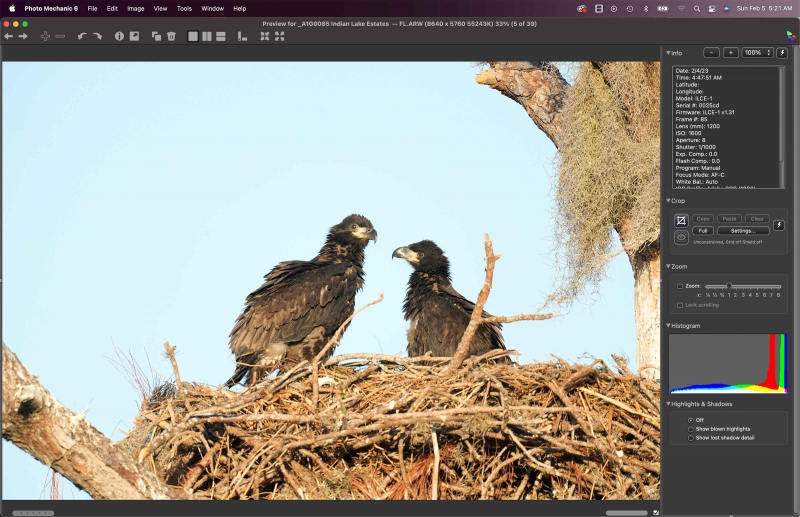

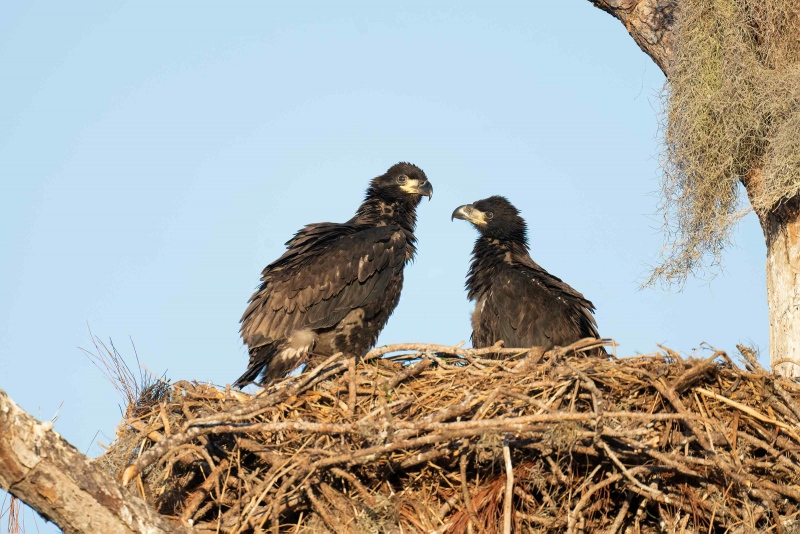
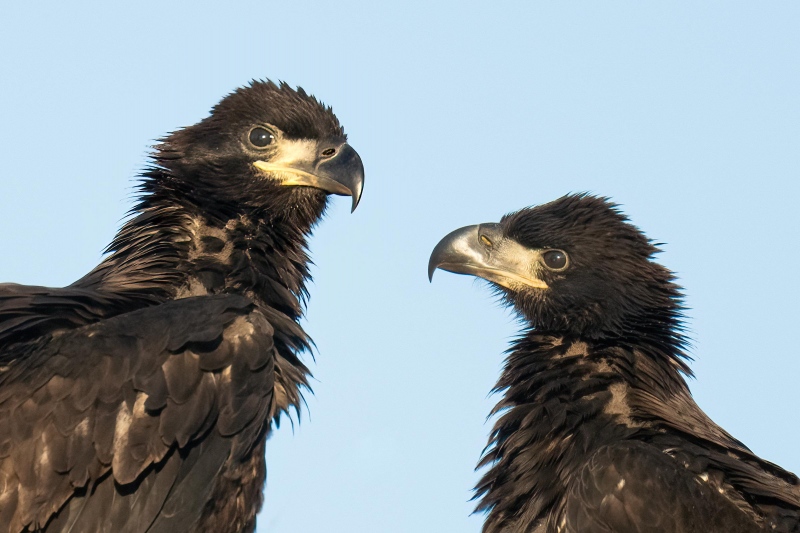
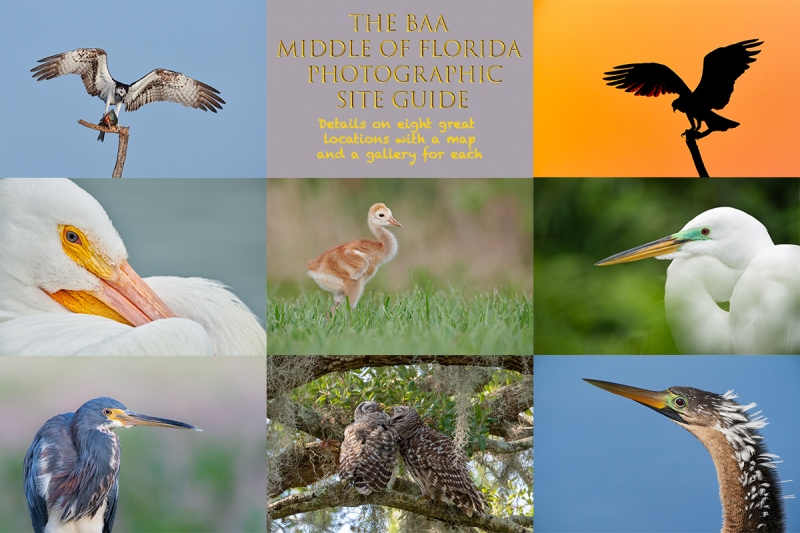













Hi, Artie. I like the optimized image best. The sticks do bother me in the original. Typo in the third paragraph under what’s up. You said the sun dropped behind a low cloud on the eastern horizon, but it must have been on the western horizon, no?
Me too :). Thanks and fixed on the directional confusion.
a
Images #1 and #1a and #1b of Two large Bald Eagle chicks in the nest are interesting! And the other image Before and After is funny to watch with it changing the sticks off and on that are on image #1 and image #1a! Well made photos!!
The sticks don’t bother me at all and to me the nest looks more believable with the sticks. Love the chick looking at its sibling.
I Like the optimised image best, of course, but the two larger twigs that you have removed, show a flat, straight cut that doesn’t look natural. I would work more on these ends to make them more ragged and natural looking, maybe lengthen them a tad?